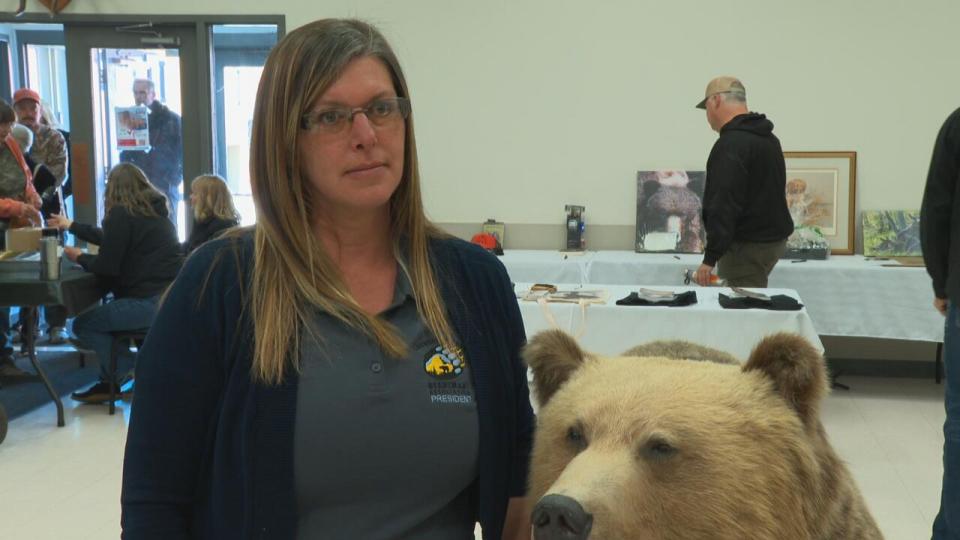Brush up on bear safety before heading into the bush, Alberta experts say

Spring is in the air, so bears are leaving dens and people have a similar instinct to get outside.
This is the time of year when wildlife experts like to get people thinking about bear safety and coexistence in provincial and national parks like Canmore and Banff — but it's something that applies in other corners of Alberta too.
Christy Pool is the president of Crowsnest Pass Bear Smart. She says the Pass has the same kinds of bears: grizzlies and black bears — but they're in a whole different element.
"When you're walking and hiking and recreating in national and provincial parks, bears that have taken up residence there are quite more comfortable with human presence," Pool said. "Whereas here the bears in this valley are not really accustomed to that."
So, she said, bears in her area might need a bit more space — and it might help to know about bear behaviours and knowing what bears are signaling to humans before heading out into the wilderness.
The group does a lot of work in Alberta's southwest to educate people and monitor the local bear population to ensure these animals stay wild and can coexist with humans.

Christy Pool speaks about the importance of being bear-smart this season. (Helen Pike/CBC)
Every time the Crowsnest Pass Bear Smart annual bear safety forum comes around, Pool said the group likes to pick a theme. This year, the focus was on the worst outcome: maulings.
Pool says, even in her part of the province, human and wildlife interactions have been climbing. And while maulings are rare, when she sees more people recreating, hunting, and spending time in the wilderness, it's a concern.
"It's a higher risk if you think about the hundreds of thousands of people that are out in the forest trees and in the parks and all these places that bears used to have to themselves," Pool said.
More than 100 people piled into the Elks Hall in Blairmore, Alta., on April 20 to take in the event, a promising sign that locals are engaged with the issue, Pool commented.

John Clarke with the Canadian Bear Safety Authority, speaks to a crowd about bear safety in Blairmore, Alta., sharing his expertise as a retired Alberta Fish and Wildlife officer. (Helen Pike/CBC)
John Clarke is a retired Alberta Fish and Wildlife officer — he investigated more than a dozen maulings during his career. These days he educates the public through his company, the Canadian Bear Safety Authority.
His courses cover bear behaviour and what to do when you encounter these predators. He said it's about more than just having bear spray with you, but having it within reach, practicing how to take it out of the holster quickly, so when you do encounter a bear that's muscle memory.
And then there's the impact people's presence can have on bear behaviour.
"The longer you stand there, the more you're going to change the animal's behaviour," Clarke said.
"The big thing that I teach, you know, you meet that predator you need to be retreating right away."

Wildlife scientist Clayton Lamb works with Biodiversity Pathways, a not-for-profit group that's studying the best ways wildlife and people can coexist. (Helen Pike/CBC)
Clarke also teaches people to suss out what the bear is doing by scanning the scene. Are they protecting a food source? Are the cubs around? Where are the cubs? Is the bear following you?
Side-stepping while scanning, he said, helps people find a safe retreat path — and if the bear keeps coming, the spray is out and ready to deploy if there's a close-range encounter.
Across the border, on the British Columbia side, wildlife scientist Clayton Lamb works with Biodiversity Pathways, a not-for-profit group that's studying the best ways wildlife and people can coexist.
Lamb says his research helps people understand the best ways to share habitats with many animals, including bears — whether that's in the woods or on a farm.
"We're seeing the human footprints certainly expand across western Canada," he said. "There are bears coming into town and going to what were historically considered people places, you know, and there's people going to historically only bear places. We're starting to overlap more and more."
Research tackles which tools work best to coexist with bears
He's based in Elk Valley, the southeastern Kootenay region of British Columbia, and a neighbour to Alberta's Crowsnest Pass.
One of his long-term research projects explores how to tackle a growing problem: the Elk Valley has one of the highest densities of grizzly bear population in western North America, but those bears are facing a lot of human-wildlife conflict and face high mortality rates as a result.
He adds that the population only sustains itself because new bears keep immigrating to the area since the landscape is a perfect habitat.
So he's been looking into different interventions people can try to help reduce the human impact of that conflict. Things like programs to remove fruit trees, investigating farmland to see where an electric fence might save the chicken coop — and even getting people to carry bear spray.
"How can we get those tools in the hands of people?" Lamb said. "It's not just studying the problems, but actually trying to solve them."

 Yahoo News
Yahoo News 
